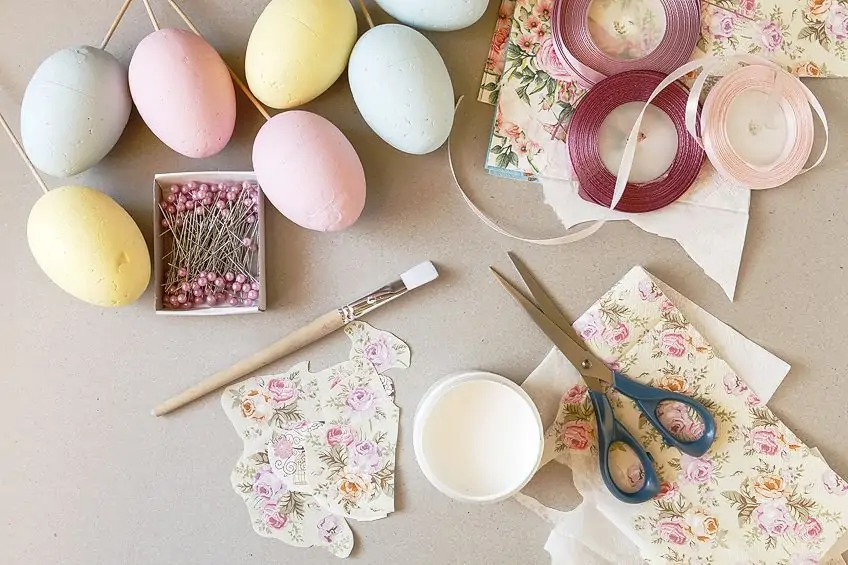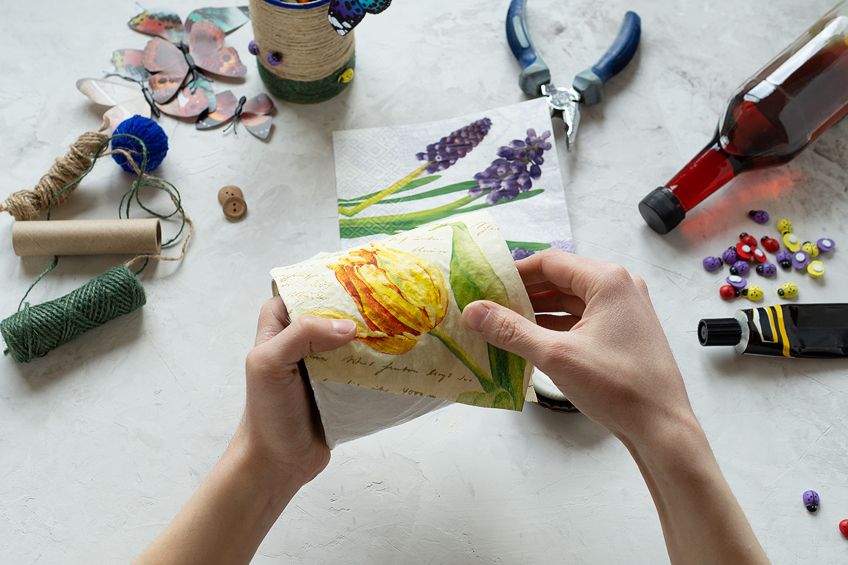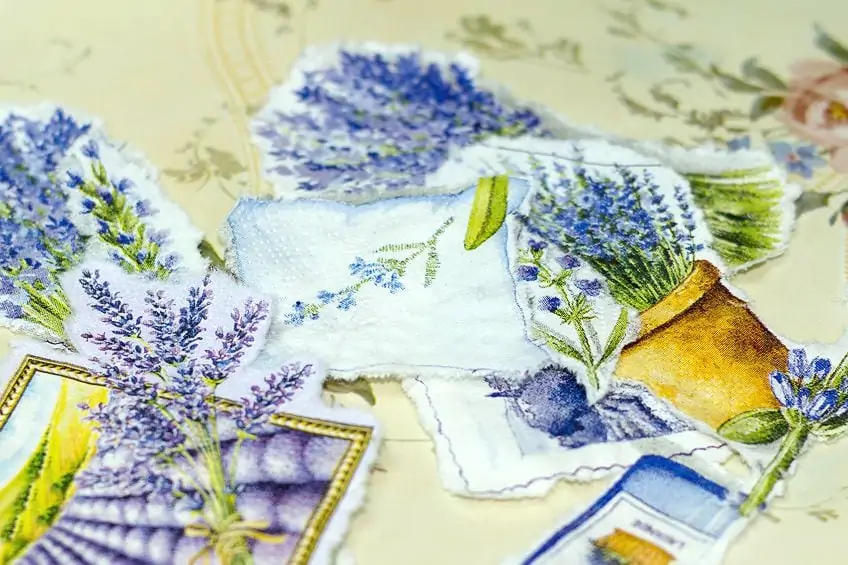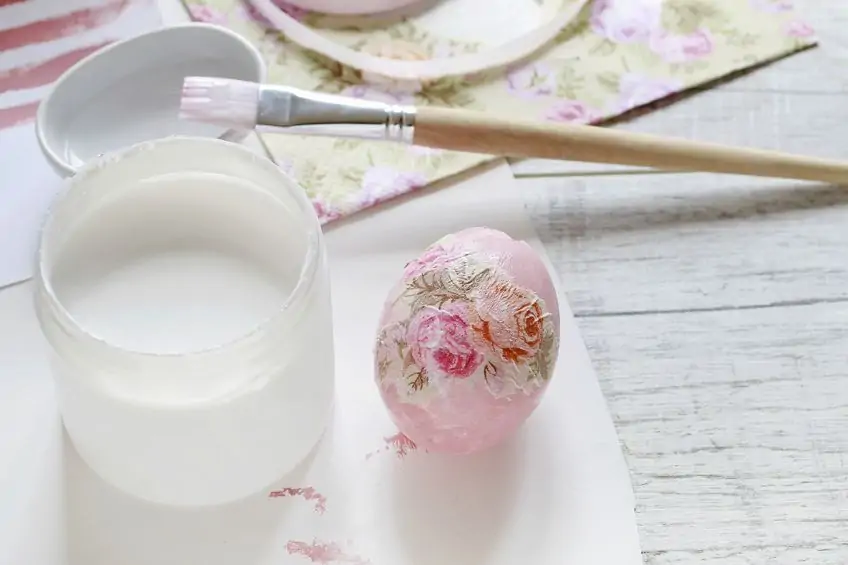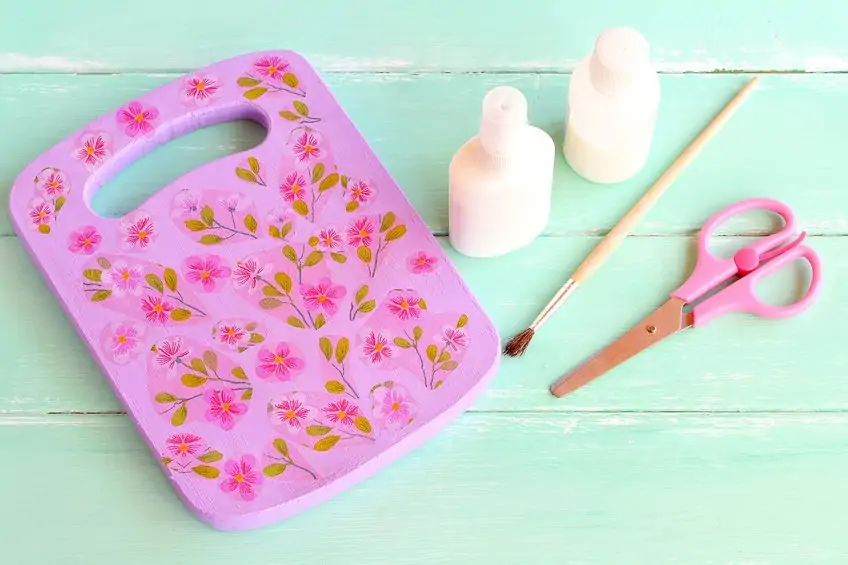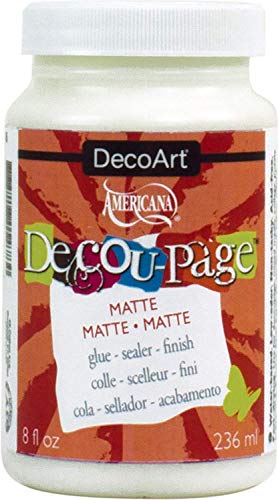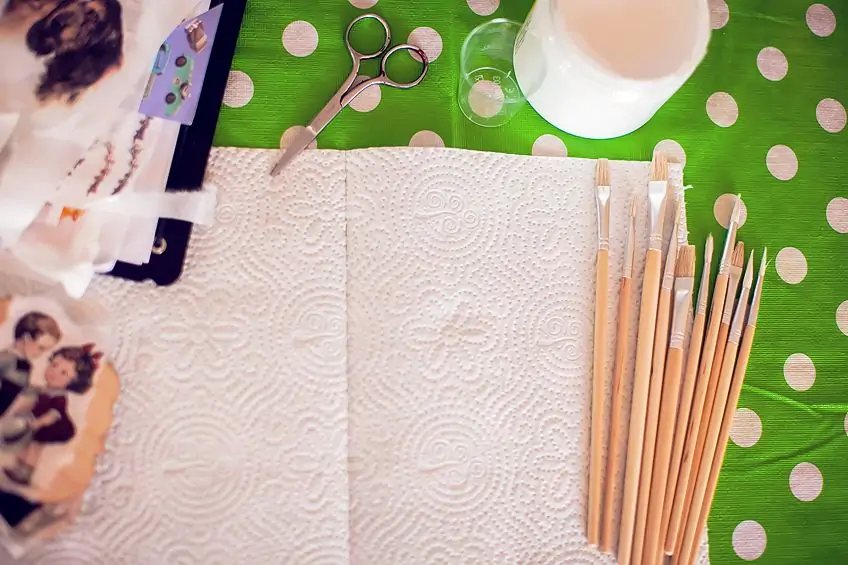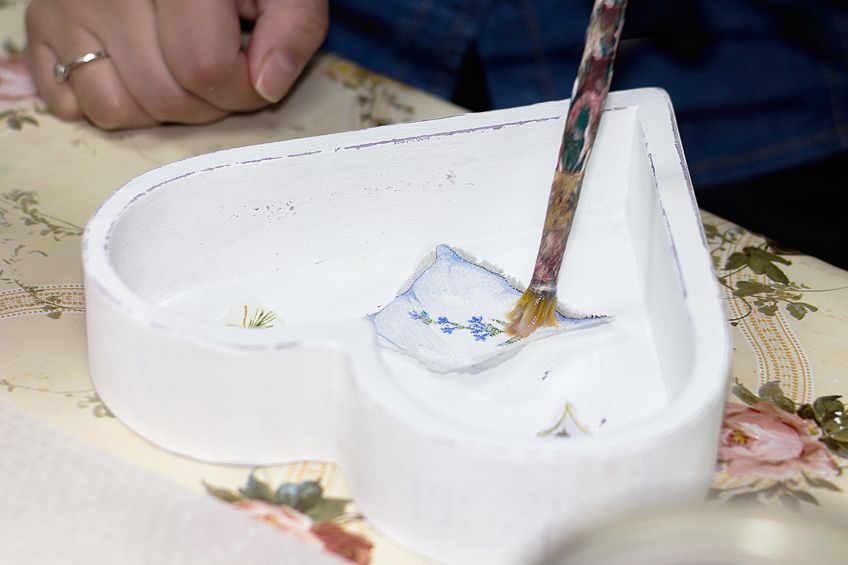Best Decoupage Glue – A Look at the Top Decoupage Mediums
This post may contain affiliate links. We may earn a small commission from purchases made through them, at no additional cost to you. You help to support resin-expert.com
There are lots of ways to spruce up your furnishings or ornate decorations in your home these days. With the sheer amount of DIY coatings, repairs, additions, treatments, and tutorials available it’s easy to get yourself turned around and paralyzed by the sheer number of choices available to you. Sometimes, it’s best to get back to basics, and it doesn’t get any simpler than decoupage. You might remember the technique from your days in kindergarten, but things have become a lot more nuanced since then. Let’s have a look at what decoupage glue is, what it can be used on and how you can go about using it to make your workpieces more interesting.
Table of Contents
What Is Decoupage?
What is Decoupage? Decoupage glue is essentially a coating that can be used to adhere coverings such as paper and graphics to a wide variety of surfaces. Once the image or graphic has adhered to the object you simply lather some varnish over it and it essentially becomes flush with the surface you have chosen.
Decoupage glue is most commonly known as an adhesive under the Mod Podge brand, which is responsible for creating a whole host of craft-related products such as the aforementioned decoupage glue, puzzle glue, stickers, and many other crafting related products.
The brand has been around since the 1960s and their brand has become synonymous with decoupage, puzzles, window art, stenciling, and other entry-level crafting activities that can prove to be both entertaining and educational no matter which age group you fall into.
At its core, Mod Podge (or decoupage glue in general) is essentially ordinary white crafting glue that has been watered down in order to attain a different consistency, this consistency is what allows one to layer it over the paper, photos, puzzles, window decorations, mirror decorations and toys in order to make things adhere to them.
Decoupage comes from the French word decouper which directly translates to “to cut or tear from something” which is somewhat accurate even though it only focuses on one half of the practice. Decoupage is seen as a serious art form, and many mixed media artists will use this technique to adhere to fabric, paper, plants, stickers, and any other material malleable enough to be stuck to their medium of choice.
A good decoupage glue (and a keen eye) will allow you to glue anything to any surface.
You usually go about applying this stuff with a brush when you’re little, but just as you’ve likely learned your world history and developed a sense of self by now, your application can be a bit more refined. Decoupage glue can be applied with an applicator which essentially resembles a conveniently shaped sponge on a stick, this applicator absorbs the watery glue and deposits it when pressure is applied to the surface of your choosing.
Decoupage glue is an easy and accessible way to take your crafting game to the next level without having to invest in tons of equipment or tools. In fact, technique, vision, and developing your own personal balance of glue and water is what sets most professionals apart from the rest of us.
Why Has Decoupage Become So Popular?
This is a good question for a number of reasons. To begin with, the art of painting has been around for nearly as long, and yet it doesn’t carry the same enthusiasm or place in popular culture as decoupage does.
Why? Well, unlike the fine discipline of painting, decoupage is not only more open to interpretation and personal style than painting, but the medium is far more accessible and malleable. The nature of decoupage is literally memetic if one considers the way it traversed cultures over centuries, infecting native peoples with its unique combination of simple practicality and complex visual impact.
In fact, there are cultures that have chosen to decorate the covering of their dead with various patterns, messages, and symbols that reflect their farewells and faith.
Decoupage art has always been popular in one sense or another, and thanks to advances in technology and those who have integrated the technique into other art mediums, it has evolved with society and with additional thanks to all the cultures and subcultures who have adopted it and contributed to the art form, we are fortunate enough to have it as the art form we know today.
Another characteristic that makes decoupage art so popular is the sheer versatility of the technique and by extension the entire medium of paper manipulation. Decoupage is at its core the manipulation and composition of paper when adhered or molded to a surface, and thanks to those who have pioneered in the field we have seen decoupage on canvas, wood, metal, brick, fabric, glass, plastic, and even vinyl surfaces.
It is a combination of all of the aforementioned elements that makes decoupage so popular regardless of nationality or cultural boundaries all over the world. However, despite all of those facets, the real reason decoupage art is so popular is simply how easy it is to pick up.
As a respected art form in virtually all sub-cultures and art movements, decoupage can be taught and experimented with at minimal cost and/or practice to make something that looks objectively good. This is a stark contrast to other fine art practices such as painting, sculpting, poetry, or sketching. It allows you to find your own way and have a ton of fun while you’re at it.
Which Types of Glue Work Best for Decoupage?
There are a few types of glue that work particularly well when it comes to decoupage, however not all glues are created equal in this regard as some have different effects on the finish of the process and others might have certain qualities that are inferior or cheaper products do not. Let’s have a look at some of the glues you can use should you decide to give decoupage a shot.
PVA Glue
PVA glue is also known as polyvinyl acetate and is more commonly referred to as wood glue. Even if you have never set foot in a workshop or crafting store you could probably identify this type of glue by smell alone, not to mention the patented white bottle with yellow top and neck that it is usually sold in.
This type of glue is viscous enough to use on decoupage projects and will allow you to confidently adhere anything from leaves to crinkle paper to your medium of choice with ease. This type of glue is readily available and can be found at most hardware and craft shops for relatively cheap.
Decoupage Glue
As you could probably tell by the name, decoupage glue is specially formulated for use on decoupage projects. What sets this glue apart from the other types of glue you could use for this exercise though?
Well, like anything that has been purpose-built, decoupage glue has a few properties that make it ideal for use in this exercise, containing things like glue (obviously) sealer, tint, finish, and varnish to ensure that you have the best overall product for decoupage.
These types of glues often cost considerably more than other general-purpose products.
Spray Glue
Another type of glue that is extremely popular in the crafting scene is spray glue. What is spray glue? Spray glue is essentially an aerosol-based adhesive that can be applied directly to a surface or material to create a bond.
Spray adhesives dry quickly, are relatively inexpensive, and are great to use for decoupage. Because these adhesives dry quickly, they are just what is needed when a project is time-sensitive. In fact, they are available in various adhesive strengths to ensure that no matter the project you need to tackle you have the peace of mind that your work will stick and dry quickly.
Our Recommendations for the Best Glue for Decoupage
As we mentioned previously, there are various glues you could use to decoupage, but some are objectively better than others in the way that they adhere and finish the end result. This being said, let’s have a look at some of the best glues for decoupage and their pros and cons. The choice is ultimately yours and will likely depend on the caliber of project you are taking on and of course, what your budget is.
Best Overall: MOD PODGE Water-Based Sealer, Glue & Decoupage Finish
On some level, you knew this was going to be our top pick. Is there anything better for the job than a product that has literally been manufactured since its inception for this exact job? Not likely. Since all the way back in the 1960s, Mod Podge has been the metaphorical backbone of the Mod Podge industry and will likely continue to be for years to come.
This is all for good reason, we assure you, considering the fact that it has pretty much anything you could ever hope for in a decoupage glue, from being a strong reliable adhesive to providing you with a clear protective finish that will last the lifetime of your workpiece.
- Easy clean up with soap and water while wet
- Quick-drying for multiple coat build-up and dries clear
- All-in-one glue, sealer, and finish that dries clear
The Mod Podge team has developed their formula to suit both the most experienced artist and the avid beginner by ensuring that their product is easy to use, non-toxic, and quick-drying.
Additionally, this decoupage glue creates minimal clean-up effort and seals off every addition to your workpiece as if it were meant to be there. There’s not an awful lot more you could ask from a project considering it’s had all of its bases covered for the better part of 40 years, although we feel that the Mod Podge team could have updated their applicator and perhaps sold it in larger quantities from time to time.
PROS
- Legacy brand
- Easy to use
- Easy to clean up
- All-in-one finish, glue, and sealer
- Non-toxic
- Dries quickly
CONS
- The base formula tends to yellow after time
- Sold in small quantities
- Other formulas can be expensive
Best Finish: GORILLA Two-Pack Decoupage
Every hero has a rival, and this isn’t always a bad thing. Mod Podge might have started the decoupage craze but the team over at Gorilla glue has made it their mission to improve upon and innovate the industry with their two-pot decoupage range.
Gorilla glue might not have the same brand legacy as the Mod Podge team, but they make up for this by simply being a great product that doesn’t simply pick up where the old masters have left off, in fact, they have created a formula that not only performs beautifully on decoupage, but they seem to have solved the yellowing problem that plagues most entry-level decoupage glue brands.
- Incredibly durable glue, sealer, and finish all in one
- Extremely water-resistant and dishwasher safe
- Crystal-clear gloss finish and non-yellowing
This means that once all the work is done you end up with a workpiece that has a sheen finish and a professional look. Gorilla Glue creates a permanent bond that is both water and impact resistant which is just perfect for those mixed media or installation art pieces you might want to attempt in the future.
Gorilla glue has also made a concerted effort to ensure that their product includes a sealer which means just like the Mod Podge we mentioned previously, this is an all-in-one product that won’t have you running around for sealer once your additions have dried.
No matter which decoupage mediums you decide to try out, Gorilla Glue has you covered.
PROS
- Water-resistant
- UV-resistant
- Does not yellow
- Easy to use
- Good value for money
- All-in-one finish, glue, and sealer
- Dries quickly
CONS
- Minimum toxicity, but can cause discomfort
- Only sold in a gloss finish
- Adhesive strength could be excessive for new crafters
Best Value: DECOART Decoupage Glue
Another legacy brand in the crafting field is the DecoArt team. If you have ever been to a crafting store you will know that this brand is instantly recognizable to both kids and adults alike for its wide range of art and craft-related products.
Their decoupage glue lives up to the reputation they have created for themselves thus far being not only effective but great value for money as well, in fact, if you were in the market for an alternative to the Mod Podge brand, we would highly recommend either DecoArt or Gorilla glue.
- Ideal all-in-one glue, sealer, and finish
- Non-toxic, durable, and dries clear
- Quick and easy to use
Gorilla glue doesn’t leave much room for error due to its adhesive strength and fast-drying formula, and although it does resist UV decay you might not want to give it a go if this is going to be your very first time having a go at decoupage.
The DecArt decoupage glue, on the other hand, provides you with a high-quality matte finish that is not only non-toxic but dries completely clear and is just as durable as Gorilla (and slightly more than Mod Podge). The matte finish might be the best for all decoupage mediums but does provide a niche look that sets any workpiece apart from the competition. What’s more is that just like the other two products we have covered thus far it is an all-in-one glue, sealer, and finish which could end up saving you a lot of time.
This product is easy to use, affordable, and comes in a 16-ounce variety for those bigger tasks, or if you simply like having some lying around in case you need it.
PROS
- Affordable
- Versatile
- Easy to use
- Available in larger volumes
- Matte finish
- All-in-one finish, glue, and sealer
- Non-yellowing
- Quick-drying
CONS
- Not seen as a professional brand
- Matte finish is not always appealing
How to Use Decoupage Glue
Below is a short tutorial detailing how to go about using decoupage glue and what you will need to get started. As much as decoupage is a form of art, it’s a form of expression too so remember to have fun and choose pictures of places, things, events, people, letters, receipts, and anything else that are close to you to make something special. To get started you will need:
- Decoupage Glue
- Scissors
- Sanding paper
- A cloth
- Your pasting surface/object
Prepare Your Surface
Unlike painting a surface, this is one coating that won’t require nearly as much elbow grease to prepare for. If you will be adhering your paper to cardboard, ensure that the surface of the board is free of dust or other particles that might become visible or hinder the glue from bonding the two surfaces. Should you be working with wood, metal, plastic, glass, vinyl, or any other metal you should give it a once-over to ensure that the surface has sufficient friction (or is simply porous enough) to receive the adhesive you have chosen.
Prepare Your Pictures/Text/Other Additions
This part is really up to interpretation as it depends on the design you have in mind. You can cut your pictures out into shapes, tear them, layer them on top of one another, form patterns with them, write on them, paint them, cut them out, it is entirely up to you.
When doing so, ensure that you keep in mind how much space is available on your workpiece as failing to do so could result in disappointment later if you cannot fit everything you wanted onto your workpiece.
Once you have everything you need cut out and prepared, it’s best to do a mock-up of where everything will be placed, or if it’s simply for fun see how the pieces you have selected look together and figure out what works best.
Gluing the Paper to Your Workpiece
Now for the fun part. Once you have all of your images ready, apply the decoupage glue to the surface of the object that will be receiving your cut-outs, once you have completely covered the intended surface in the glue adhere your cut-outs to the surface.
Now that you have all your images neatly arranged (or not so neatly arranged), it’s time for you to get out your brush or applicator and apply a layer of decoupage glue to the surface of the pictures you have just stuck on.
When doing so, ensure that you have all of the pictures flat, and any bumps or wrinkles should be flattened out so that your surface is flush with the body of the workpiece you have adhered it to. Once you have everything flattened out it’s time for you to clean off any excess glue that might be present with a cloth that can be slightly damp but not wet.
Seal Your Workpiece (Optional)
Since most of the decoupage glue products we have covered previously have been self-sealing this step won’t be necessary if you have purchased one of them. If not, you will need to get some varnish to seal off your workpiece once all of the glue has dried completely.
Decoupage is pretty exciting, and a common mistake is to seal your piece too soon, therefore we recommend waiting for the manufacturer’s recommended time period before attempting to add a varnish sealer. Once you are sure your workpiece is dry and have applied your sealer, you should be able to see that it has taken on a glossy, seamless appearance.
Now that you know what the best glue for decoupage is, why decoupage is so popular, how to apply decoupage glue correctly, and even which other glues work best for decoupage it’s time for you to go out there and put your newfound knowledge to the test. Remember that some glues can be toxic and to always work in a well-ventilated area, and most importantly, have fun!
Frequently Asked Questions
Is Decoupage the Same as Mod Podge?
Decoupage and Mod Podge, although synonymous with one another, are two completely different things. Where Mod Podge is a brand name of glue used in decoupage, decoupage itself is an art form that consists of adhering various materials to various surfaces (although primarily paper). Mod Podge is considered by many to be the best decoupage glue on the market.
Is Decoupage Waterproof?
Although many decoupage types of glue these days are water resistant such as the offering from Gorilla Glue, they are most certainly not waterproof. Although your workpiece will not fall apart the second some water droplets land on its surface, if it becomes submerged in water, the bonds of the decoupage glue will most certainly fail.
Do You Need Special Paper for Decoupage?
No, you do not. You can use virtually any paper or material with similar characteristics to decoupage. One could use things such as fabric, leaves, photographs, newspaper clippings, recipes, ticket stubs, and even flowers if they have been compressed. You are only limited by your quality of glue and your imagination.


